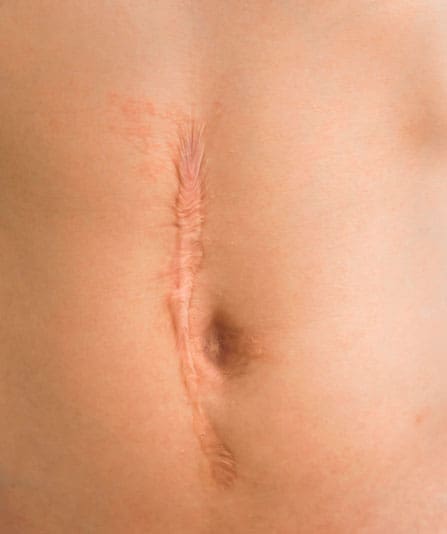Scars by Mr Ioannis Goutos
Hypertrophic Scars

Scarring can occur following any damage, infection or inflammation to the skin. As part of the healing process, collagen (a type of connective tissue) is laid down within the skin during the proliferative phase of wound healing. Scars can be categorised based on the amount of collagen that is produced within the scar.
If excessive amounts of collagen are present, then the scar is said to be ‘hypertrophic’ and will typically have a raised, red and lumpy appearance. The dimensions of hypertrophic scars usually remain with the bounadaries of the original injury site. They are usually seen in younger individuals who have had precipitating injuries such as a burn.
Hypertrophic scars can take a number of months to fully develop but will then usually self-resolve through the process of scar maturation. Scar maturation is a gradual process that typically takes 1-2 years (although sometimes longer).
Hypertrophic scars can become troublesome if they are in a prominent location that makes people feel self-conscious, cause pain or itching, or are restricting movement (for example if they are overlying a joint).
Mr Ioannis Goutos is an experienced plastic surgeon with a special academic and clinical interest in the care and management of scars and burns. He has a passion for understanding and exploring all aspects of burn and scar care, including the psychodynamic principles which may affect a person’s life and functioning due to their scar.
Book your consultation today
Book nowAbout this condition
There are a number of risk factors that increase the risk of developing hypertrophic scars. These include:
- Poor initial wound healing due to complications such as infection.
- A family history, or genetic predisposition to developing hypertrophic scarring
- The original area of skin that is injured. Although they can occur anywhere on the body, hypertrophic scars tend to be more common on areas of increased tension, such as the back, chest,
- shoulders or overlying joints such as the wrist.
- The type of original injury causing the scar. Hypertrophic scars are more common following burn injuries, in particular deep dermal or full thickness burns
It is currently understood that in the formation of hypertrophic scars, specific types of cells involved in the wound healing process, called ‘fibroblasts’ and ‘myofibroblasts’, produce too much collagen (which is stiff). This means that the resultant scar is thicker, raised and stiff compared to a normal scar. The exact reason for this imbalance in scar formation is not yet fully understood.
Whilst the appearance of hypertrophic scars can improve with time, there are several procedures and treatment options that can help to flatten, soften and reduce the amount of colour or pigment in the scar. These are similar to the treatment options for keloid scars and include:
- Topical therapies such as the use of silicone sheets or steroid plasters
- Appropriate soft tissue and massage techniques
- Steroid injections, which can be performed multiple times on the same scar. These mainly aim to flatten and soften the scar as well as improve symptoms such as pain or itching in the scar
- Laser therapies that aim to both flatten and soften hypertrophic scars
- Surgical removal of the scar and closure using appropriate techniques (e.g a wavy line pattern) to reduce the risk of the hypertrophic scar reforming.
- Needling techniques
If you are worried about getting hypertrophic scars, or know that you are prone to developing them, there are a number of steps that can be taken to reduce the risk of poor scar healing and formation of bulky scars. The first steps to consider include proper wound aftercare following an injury or surgery:
- Ensure that the wound stays clean by using appropriate dressing materials as directed by your specialist
- Keep the skin well hydrated by using non-fragranced emollients and ensuring that you are also drinking enough water
- Stop smoking to help improve the initial healing process of the wound
- Once the wound has healed, avoid exposure of the scar to direct sunlight by wearing appropriate clothing and regularly applying sunscreens with a good SPF (at least 30)
- Attend all follow up appointments and adhere to advice from the healthcare professionals assessing your wound and scars. These are good opportunities to ask any questions you have about good wound care.
Additionally, if you are planning to have surgery and know you are prone to getting hypertrophic scarring, it is important to discuss this with your surgeon before the operation. There are additional measures that can be taken during the surgery itself to try and reduce the risk of unsightly scar formation. These techniques include careful planning of the incision line(s) to respect the natural creases in the skin and closing the surgical wound using special tension-relieving techniques. There may also be additional adjuncts to be included in the post-operative care of the wound to improve the healing process and produce improved cosmetic results.

Related conditions
Suspendisse diam ligula, hendrerit a risus eu, rhoncus porta elit. Pellentesque consectetur eget ligula ac posuere.
Testimonials
Mr Goutos is delighted to share some of his patient and peer feedback on their experiences of his services.













